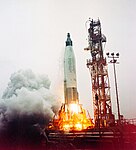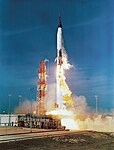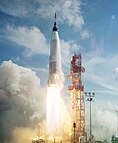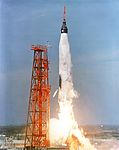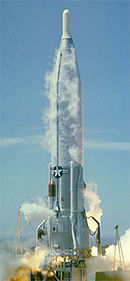The SM-65 Atlas was the first operational intercontinental ballistic missile (ICBM) developed by the United States and the first member of the Atlas rocket family. It was built for the U.S. Air Force by the Convair Division of General Dynamics at an assembly plant located in Kearny Mesa, San Diego.

Mercury-Atlas 7, launched May 24, 1962, was the fourth crewed flight of Project Mercury. The spacecraft, named Aurora 7, was piloted by astronaut Scott Carpenter. He was the sixth human to fly in space. The mission used Mercury spacecraft No. 18 and Atlas launch vehicle No. 107-D.

The Agena Target Vehicle, also known as Gemini-Agena Target Vehicle (GATV), was an uncrewed spacecraft used by NASA during its Gemini program to develop and practice orbital space rendezvous and docking techniques, and to perform large orbital changes, in preparation for the Apollo program lunar missions. The spacecraft was based on Lockheed Aircraft's Agena-D upper stage rocket, fitted with a docking target manufactured by McDonnell Aircraft. The name 'Agena' derived from the star Beta Centauri, also known as Agena. The combined spacecraft was a 26-foot (7.92 m)-long cylinder with a diameter of 5 feet (1.52 m), placed into low Earth orbit with the Atlas-Agena launch vehicle. It carried about 14,000 pounds (6,400 kg) of propellant and gas at launch, and had a gross mass at orbital insertion of about 7,200 pounds (3,300 kg).

Big Joe 1 (Atlas-10D) launched an uncrewed boilerplate Mercury capsule from Cape Canaveral, Florida on 9 September 1959. The purposes of the Big Joe 1 were to test the Mercury spacecraft ablative heat shield, afterbody heating, reentry dynamics attitude control and recovery capability. It was also the first launch of a spacecraft in Project Mercury.
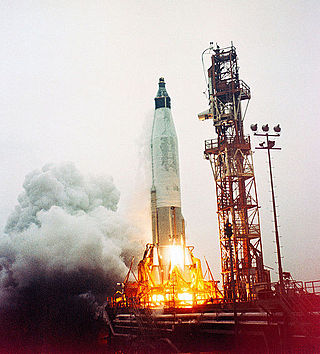
Mercury-Atlas 1 (MA-1) was the first attempt to launch a Mercury capsule and occurred on July 29, 1960 at Cape Canaveral, Florida. The spacecraft was unmanned and carried no launch escape system. The Atlas rocket suffered a structural failure 58 seconds after launch at an altitude of approximately 30,000 feet (9.1 km) and 11,000 feet (3.4 km) down range. All telemetry signals suddenly ceased as the vehicle was passing through Max Q. Because the day was rainy and overcast, the booster was out of sight from 26 seconds after launch, and it was impossible to see what happened.

Mercury-Atlas 4 (MA-4) was an uncrewed test flight within NASA's Project Mercury program, launched on September 13, 1961, at 14:04:16 UTC from Cape Canaveral Air Force Station Launch Complex 14. The mission's primary purpose was to evaluate the Mercury spacecraft's performance in orbit and to test the Mercury Space Flight Network. Despite initial technical challenges, Mercury-Atlas 4 successfully met its goals. The mission involved testing the Mercury spacecraft, specifically Mercury #8A, which completed one orbit around Earth. This successful flight provided important data and insights for NASA's Project Mercury, supporting the planning and development of upcoming crewed missions in the program.

Mercury-Atlas 2 (MA-2) was an uncrewed test flight of the Mercury program using the Atlas rocket. It launched on February 21, 1961, at 14:10 UTC, from Launch Complex 14 at Cape Canaveral, Florida, United States.

The Atlas-Centaur was a United States expendable launch vehicle derived from the SM-65 Atlas D missile. The vehicle featured a Centaur upper stage, the first such stage to use high-performance liquid hydrogen as fuel. Launches were conducted from Launch Complex 36 at the Cape Canaveral Air Force Station (CCAFS) in Florida. After a strenuous flight test program, Atlas-Centaur went on to launch several crucial spaceflight missions for the United States, including Surveyor 1, Mariner 4, and Pioneer 10/11. The vehicle would be continuously developed and improved into the 1990s, with the last direct descendant being the highly successful Atlas II.
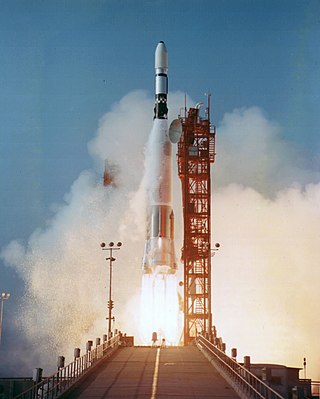
The Atlas-Agena was an American expendable launch system derived from the SM-65 Atlas missile. It was a member of the Atlas family of rockets, and was launched 109 times between 1960 and 1978. It was used to launch the first five Mariner uncrewed probes to the planets Venus and Mars, and the Ranger and Lunar Orbiter uncrewed probes to the Moon. The upper stage was also used as an uncrewed orbital target vehicle for the Gemini crewed spacecraft to practice rendezvous and docking. However, the launch vehicle family was originally developed for the Air Force and most of its launches were classified DoD payloads.

Atlas is a family of US missiles and space launch vehicles that originated with the SM-65 Atlas. The Atlas intercontinental ballistic missile (ICBM) program was initiated in the late 1950s under the Convair Division of General Dynamics. Atlas was a liquid propellant rocket burning RP-1 kerosene fuel with liquid oxygen in three engines configured in an unusual "stage-and-a-half" or "parallel staging" design: two outboard booster engines were jettisoned along with supporting structures during ascent, while the center sustainer engine, propellant tanks and other structural elements remained connected through propellant depletion and engine shutdown.

The Convair SM-65A Atlas, or Atlas A, was the first full-scale prototype of the Atlas missile, which first flew on 11 June 1957. Unlike later versions of the Atlas missile, the Atlas A did not feature the stage and a half design. Instead, the booster engines were fixed in place, and the sustainer engine was omitted. The propulsion system used on the initial Atlas As was an early version of the Rocketdyne MA-1 engines with conical thrust chambers that produced a mere 135,000 pounds of thrust, compared with the 360,000 pounds of the fully operational Atlas D. Several pieces of hardware found on the operational Atlas were either missing on the A-series or only partially implemented. Powered flight on the A-series would last about two minutes and compared to later Atlases, long pad hold-down times, with up to 11 seconds between engine start and launcher release.

The Convair SM-65B Atlas, or Atlas B, also designated X-12 was a prototype of the Atlas missile. First flown on 19 July 1958, the Atlas B was the first version of the Atlas rocket to use the stage and a half design with an operational sustainer engine and jettisonable booster engine section. Unlike later Atlas models, the Atlas B used explosive bolts to jettison the booster section.

The SM-65C Atlas, or Atlas C was a prototype of the Atlas missile. First flown on 24 December 1958, the Atlas C was the final development version of the Atlas rocket, prior to the operational Atlas D. It was originally planned to be used as the first stage of the Atlas-Able rocket, but following an explosion during a static test on 24 September 1959, this was abandoned in favor of the Atlas D. Atlas C was similar to Atlas B, but had a larger LOX tank and smaller RP-1 tank due to technical changes to the Rocketdyne engines. Improvements in materials and manufacturing processes also resulted in lighter-weight components than the Atlas A and B. Booster burn time was much longer than the A/B series, up to 151 seconds. All launches took place from LC-12 at CCAS.

The SM-65D Atlas, or Atlas D, was the first operational version of the U.S. Atlas missile. Atlas D was first used as an intercontinental ballistic missile (ICBM) to deliver a nuclear weapon payload on a suborbital trajectory. It was later developed as a launch vehicle to carry a payload to low Earth orbit on its own, and later to geosynchronous orbit, to the Moon, Venus, or Mars with the Agena or Centaur upper stage.
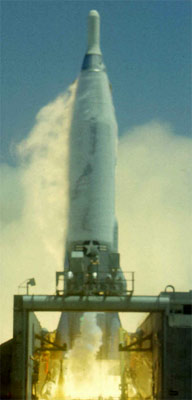
The SM-65E Atlas, or Atlas-E, was an operational variant of the Atlas missile. It first flew on October 11, 1960, and was deployed as an operational ICBM from September 1961 until April 1966. Following retirement as an ICBM, the Atlas-E, along with the Atlas-F, was refurbished for orbital launches as the Atlas E/F. The last Atlas E/F launch was conducted on March 24, 1995, using a rocket which had originally been built as an Atlas E.
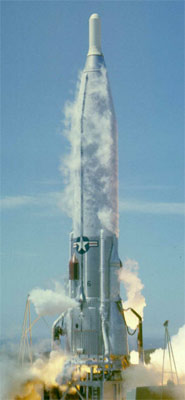
The SM-65F Atlas, or Atlas-F, was the final operational variant of the Atlas missile, only differing from the Atlas E in the launch facility and guidance package used. It first flew on 8 August 1961, and was deployed as an operational ICBM between 1961 and 1966. Following retirement as an ICBM, the Atlas-F, along with the Atlas-E, was refurbished for orbital launches as the Atlas E/F.
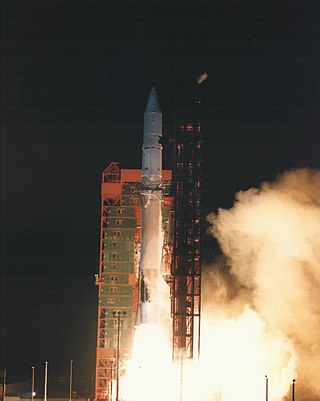
The Atlas G, also known as Atlas G Centaur-D1AR was an American expendable launch system derived from the Atlas-Centaur. It was a member of the Atlas family of rockets and was used to launch seven communication satellites during the mid to late 1980s. Atlas G consisted of an improved Atlas core with modernized avionics and stretched propellant tanks. The Centaur stage also had several updated components and other technical improvements. Atlas G flew 7 times, with all missions aiming to go to a geostationary transfer orbit. It was replaced by the near-identical Atlas I, which had an improved guidance system and offered a larger payload fairing.
The Atlas SLV-3, or SLV-3 Atlas was an American expendable launch system derived from the SM-65 Atlas / SM-65D Atlas missile. It was a member of the Atlas family of rockets.
The Mercury-Redstone Launch Vehicle, designed for NASA's Project Mercury, was the first American crewed space booster. It was used for six sub-orbital Mercury flights from 1960–1961; culminating with the launch of the first, and 11 weeks later, the second American in space. The four subsequent Mercury human spaceflights used the more powerful Atlas booster to enter low Earth orbit.



